Exotic Liriomyza leafminers
Since 2015, three of the five serious, pest exotic leafminers have made their way to Australia, with one now present in Victoria.
In May 2022, suspect leafminer samples collected west of Melbourne were confirmed as the exotic serpentine leafminer (Liriomyza huidobrensis). It was first detected in Australia in October 2020 in New South Wales. The NSW Department of Primary Industries launched an emergency response to this detection that involved surveillance and tracing to delimit the extent of the infestation. In early 2021, the response transitioned to management once it was determined that it was not technically feasible to eradicate. The pest is now considered established in New South Wales, Queensland and Victoria.
Exotic polyphagous leafmining flies of the genus Liriomyza are pests that pose a serious threat to Australian agricultural and horticultural industries. Australia has a number of Liriomyza species already present in Australia, but they do not impact on horticultural production. Leafminers feed in tunnels under the leaf surface – these tunnels cause visible damage which are referred to as ‘mines’.
Description
There are over 300 species of Liriomyza worldwide, with only five of these considered significant pests that are known to attack a wide variety of plants:
- Liriomyza sativae (vegetable leafminer) – detected in Torres Strait and Northern Peninsula Area of Queensland in 2015, under official control
- Liriomyza huidobrensis (serpentine leaf miner) – exotic species established in Victoria, New South Wales and Queensland since 2020
- Liriomyza trifolii (American serpentine leafminer) – established in Torres Strait, Northern Peninsula Area of Queensland and northern Western Australia since 2021.
- Liriomyza bryoniae (tomato leafminer) – not present in Australia
- Liriomyza cicerina (chickpea leafminer) – not present in Australia
Adults
The adult flies of Liriomyza species, including exotic and local species present in Australia look very similar. Reliable identification requires examination under a microscope. They are small (1 to 3mm) grey-black flies with yellow markings (Figures 1 and 2).
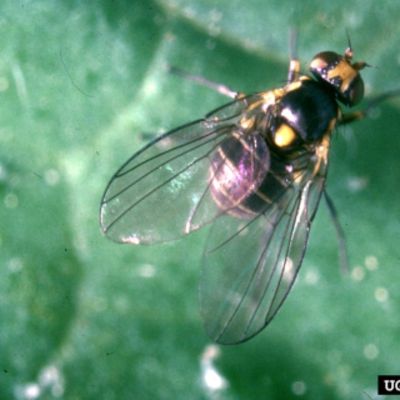
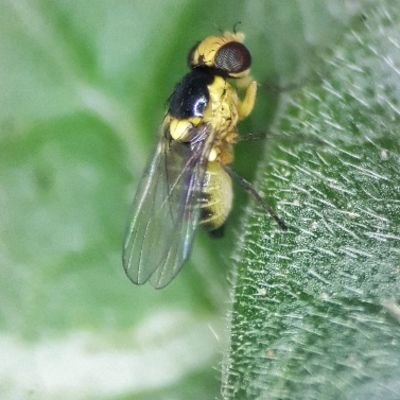
Larvae
The larvae of Liriomyza leafminers are yellow to white in colour and feed in the living plant tissue in tunnels beneath the surface of the plant. The larvae are very small and cannot be seen easily – only larval mining tunnels can be seen on the leaves of infested plants (Figures 3 and 4).
Damage
Exotic leafminers leave squiggly white lines on impacted host plants (Figures 3–5). Tunnel patterns and sizes vary with different species. Heavy tunnelling damage reduces the ability of the plant to photosynthesise, which can result in leaf death or premature leaf drop. Heavy infestations can leave stippling damage on plants from the feeding and egg-laying sites of the adult females. Mine damage can also reduce crop yield and leave leafy green crops unmarketable due to the tunnelling left behind.
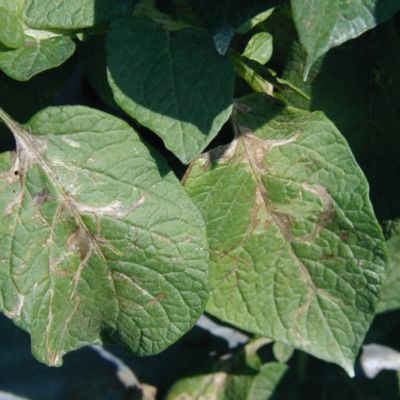
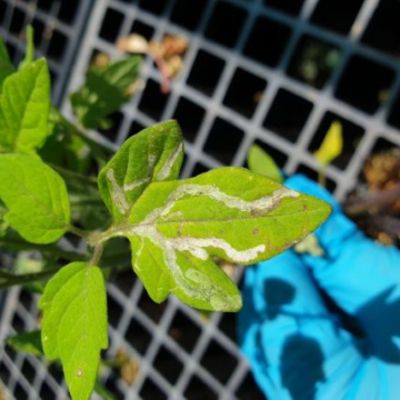
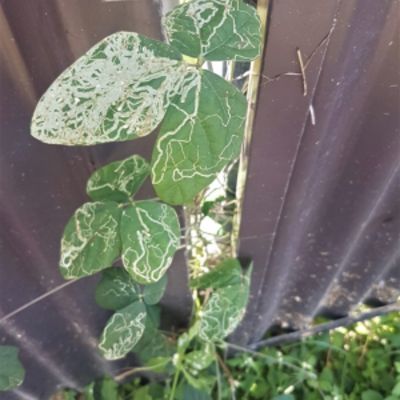
Hosts
Exotic leafminers have a very wide host ranges, including common weeds in the Asteraceae (sowthistle) and Solanaceae (nightshade) and Fabaceae families. Common vegetable crop hosts include:
- bean
- cabbage
- capsicum
- celery
- chilli
- cucumber
- eggplant
- lettuce
- onion
- peas
- potato
- tomato.
Distribution
Each of these exotic leafminers have different distributions.
- Liriomyza trifolii is found worldwide and is now established in Torres Strait, Northern Peninsula Area of Queensland and northern Western Australia.
- L. huidobrensis is widespread in Africa, Central America, South America, Europe, Asia and now established in Victoria, New South Wales and Queensland in Australia.
- Liriomyza sativae is found almost worldwide, including under official control in Torres Strait and Northern Peninsula Area of Queensland.
- Liriomyza bryoniae is present in Europe, Asia and North Africa and L. cicerina is present in Africa, Europe and the Middle East.
Spread
Leafminers are spread through the movement of live host plants containing eggs, larvae, or adults, as well as the movement of pupae via contaminated soil.
Adult leafminers are typically poor fliers, moving only short distances between crops, but can also travel long distances by hitchhiking via human movements or through wind dispersal.
Recognising exotic leafminers
Leafminer damage caused by local leafminer species is generally not distinguishable from an exotic leafminer. Therefore, any suspect leafminer damage should be reported. If you suspect an exotic leafminer infestation, you should report it immediately.
More information
Image credits
Figure 1 courtesy of Central Science Laboratory, Harpenden , British Crown, Bugwood.org
Figure 2 courtesy of Dr Elia Pirtle, Cesar Australia.
Figure 3 courtesy of Dr Peter Ridland.
Figure 4 courtesy of NSW DPI.
Figure 5 courtesy of Dr Elia Pirtle, Cesar Australia
Reporting an unusual plant insect pest or disease
Report any unusual plant pest or disease immediately using our online reporting form or by calling the Exotic Plant Pest Hotline on 1800 084 881. Early reporting increases the chance of effective control and eradication.
Please take multiple good quality photos of the pests or damage to include in your report where possible, as this is essential for rapid pest and disease diagnosis and response.
Your report will be responded to by an experienced staff member, who may seek more information about the detection and explain next steps.
Report online